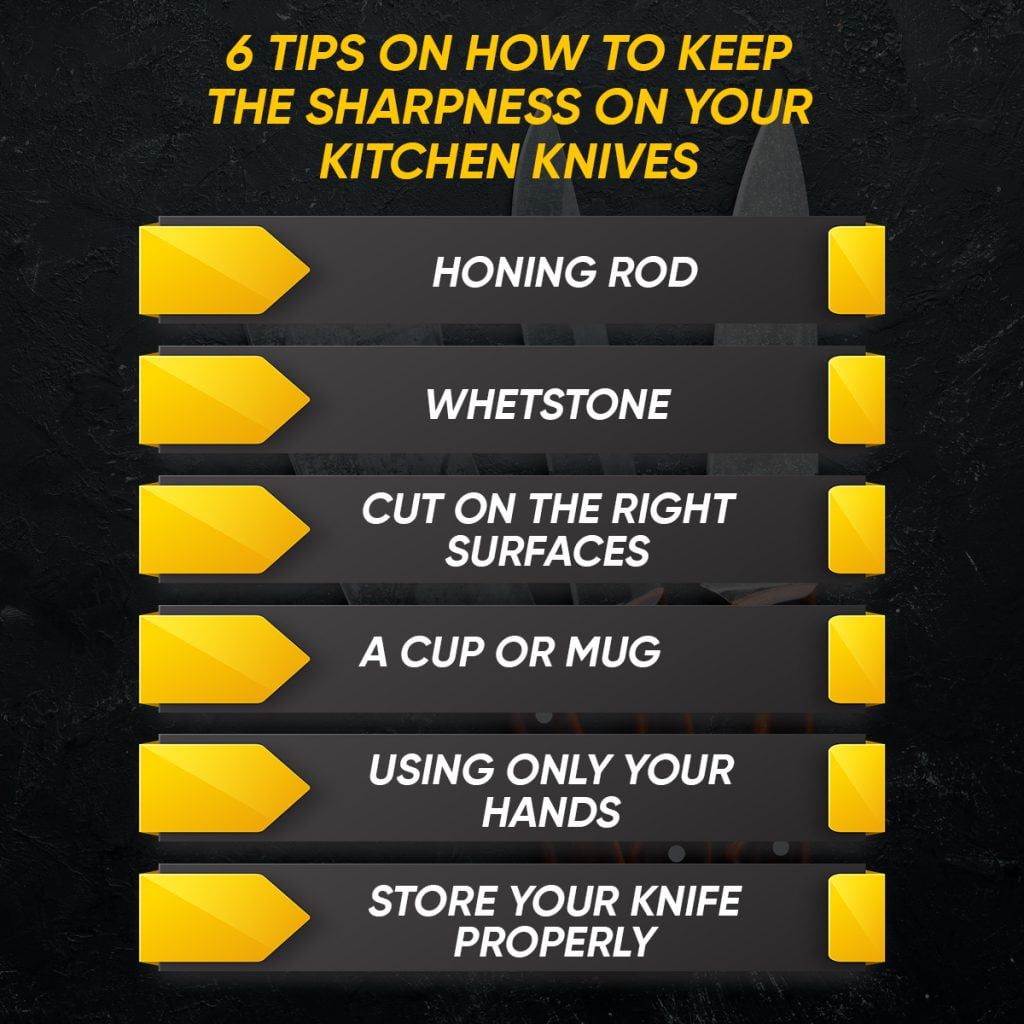Sharpening and maintaining kitchen knives is a lot simpler than you would imagine. Now the major question is: how to keep your kitchen knives sharp? The following are suggestions on how to sharpen kitchen knives at home.
Let’s continue!
Table of contents
Estimated reading time: 6 minutes
What Dulls Knives?
When the coronavirus epidemic began in the spring, we found ourselves in the kitchen a lot more than usual. And we’re still preparing the meal! Every day of the w
When the coronavirus epidemic began in the spring, we found ourselves in the kitchen a lot more than usual. And we’re still preparing the meal!
Every day of the week, three meals a day is the norm for many. This implies that our kitchen knives are receiving far more utilization than usual, which will eventually cause the blades to get dull.
Dull knives shred food instead of cutting it, and this can be harmful because it requires more power to cut food with them than with sharp knives.
It is usual for knives to get dull over time. Nevertheless, there are situations when this occurs because we did not take adequate care of a knife blade.
6 Tips on How to Keep the Sharpness on Your Kitchen Knives

When it comes to food preparation, having the appropriate tools is necessary. From what I can see, your knives are put through a significant amount of work each day.
During the course of your meals, you will use them to cut your meat, chop your veggies, and slice your food into little pieces.
If you discover that the components you are cutting are tearing before you can completely slice through them, the knife you are using may be too dull.
So you need the best way to sharpen a knife at home.
To keep a knife sharp, you’ll need to practice a little. But it won’t take much time. Here are 6 easy kitchen knife care tips:

1. Honing Rod
The kitchen knife set may have included a sharpening rod. A honing rod, often called sharpening steel, resembles a short sword. It realigns your knife’s metal without removing much of it.
With the rod in your non-dominant hand, you grasp the knife in your dominant one. It is best to raise the rod’s end above the handle.
Hold the knife at a 20-degree angle to the rod while keeping your fingers away from the blade. It would help to slide the knife across the rod’s upper surface with your arm, hand, and wrist.
Repeat on the knife’s other side. Before using your knife, make six to eight turns.
2. Whetstone
How to keep kitchen knives sharp at home with a stone? Well, this method is easy to apply.
When using a whetstone, diamond, or sharpening stone, it’s essential to realize that the stone has two sides: a rough and a fine. When sharpening a knife, you begin by slicing it in the opposite direction of how you would cut a piece out of the stone.
About two-thirds of the way through the blade, grind the knife’s edge across the burr. Different methods of grinding exist. Only grind one side of the blade for a one-sided advantage, or grind both sides for a symmetrical grind.
Afterward, switch to a finer-grit stone to remove any burrs that may have been formed on the blade. Once it’s smooth enough, go back and forth between the two sides of the knife with each pass.
3. Cut on the Right Surfaces
The state of your knives is closely related to the cutting surfaces you utilize. Stainless steel, granite, and aluminum are all examples of surfaces to avoid.
Cutting wood, plastic, or polyethylene typically goes without a hitch. You should be fine as long as you’re using a cutting board made of the correct materials.

4. A Cup or Mug
It’s possible to keep kitchen knives sharp without using any special equipment if you don’t have one. You may rapidly sharpen your knife by rubbing it against the bottom of a ceramic cup or mug.
Slide the blade of your knife through the grit on both sides of the edge of the cup while maintaining a consistent 20-degree angle.
If you have access to a honing rod, use it to finish the process of sharpening your blade.
Marks on the blade side are too high, and the airside is too shallow.
5. Using Only Your Hands
Many folks toss their knives in the dishwasher and don’t give them another consideration.
While this may seem like an ideal method for cleaning your knives, the constant bombardment of heat, water, and detergent on your blades gradually wears them down.
Instead, take the time to wash your knives by hand and make sure they’re spotless.
It’s always good to sharpen your knives before each use, but cleaning them by hand may help keep their edge longer.
6. Store Your Knife Properly
If you don’t have a dishwasher, you may want to consider chucking your best knives into the dishwasher. All of your knives should be kept in a single location.
Knives can have their own dedicated drawer. In addition to wooden blocks or knife blocks, they may also be used to keep a full set of knives and a honing rod.
A magnetic board may be used in commercial kitchens to access knives quickly. Using a magnetic board in a household with small children or pets is not suggested.
What Are The Best Knives In 2022 For Kitchen Use
The foundation of your culinary equipment is a sharp knife. Without a proper knife in your kitchen, nothing gets done.
I’ve tried a lot of kitchen knives, but these three performed flawlessly in every situation:
| Title | Key Features |
| Imarku Japanese Kitchen knife | Ergonomic Handle. High-carbon stainless steel blade. Multi-functional knife. |
| Henckels Classic 8″ Chef Knife | Budget-friendly. Highly durable. |
| WÜSTHOF Classic 8 Inch Chef’s Knife | Razor-sharp. Versatile. Dishwasher safe. |

Wrapping Up
This is all about how to keep your kitchen knives sharp. When you take care of your knives, you’re less likely to have difficulties like torn ingredients when slicing.
Kitchen knives are crucial. To get the best performance out of them, maintain them just like you would any other tool in your house.
Knives last longer if you maintain them sharply, store them appropriately, and only use them on acceptable surfaces. Keep in mind that rinsing and drying your knife with a soft cloth after sharpened can help eliminate any remaining metal shavings.
Enjoy the enhanced sharpness of your blades and observe how it impacts your food preparation!

Read More:




